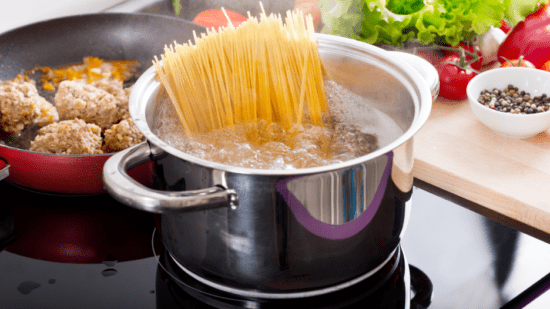If you are a home gourmand, and spend a lot of fresh and high-quality ingredients to make culinary masterpieces in your own kitchen, you may be able to further improve the quality of your results by improving the water you are cooking with. Water isn’t the most obvious thing we consider when cooking, as we tend to think that water is water. And while this is true, water almost always contains more than simply H2O. Anything and everything on the planet can (and does) find its way into water, making it a very tricky substance to work with, and to cook with. We’ll consider some basics of water chemistry in this article, and see how switching to water that has been properly filtered can improve your overall health, as well as the flavor of your meals.
Contents
Water Quality Explained: A Quick Look
Water is a powerful solvent, with the ability to take other substances and break them down into their constituent components. It does this slowly, and over time, but so effectively that it has earned the nickname of the “universal solvent,” because of how many substances and compounds it can break down. So, what does this mean for your cooking? Simply that water is a vector for anything and everything that it has come into contact with, from microbial threats such as viruses and bacteria, to minerals and heavy metals, to a whole host of human-made synthetic threats, from pesticides and pharmaceuticals to emerging threats such as microplastics and PFAS (also called “forever chemicals”).
Water, in its natural state, is generally unsafe for human consumption, which is why developed nations spend a great deal of money annually to provide clean, potable water, and why providing water of drinkable, safe quality is an international problem, with as much as 25% of the world’s population lacking reliable access to safe drinking water.

Even in areas with generally good municipal water treatment systems, however, such as the United States, water can still be full of elements that are best removed, both for health reasons, but often just as much for the sake of aesthetic improvements to water for both drinking and cooking. Tap water is usually drawn from a municipal source, in which case it almost certainly has chlorine in it, as well as other potential disinfectants (and potential disinfection byproducts, such as Trihalomethanes). In some cases, your tap water will come from a well or spring, in which case, it could contain any number of problematic elements, especially if it is a small and unregulated well. In such cases, the water should be professionally tested, and steps taken to address any pressing microbial threats.
The Impact of Water Quality on Cooking
Water is one of the most consistently utilized resources in the kitchen. It is required in nearly all dishes, whether as an ingredient, a cooking or preparatory step, or in some other way. This is hardly surprising, given that the meats, grains, fruits, and vegetables that we are preparing are all water-based forms of life. Water is simply central to cooking, and high-quality water is necessary if you want to achieve the best possible results.
Taste and Flavor
Problematic water–whatever its contents–can carry a negative scent and flavor with it. Sulfurous water can taste of rotten eggs, while sediment-rich water may taste earthy and vaguely dirty. Water heavily treated with chlorine and/or chloramines (disinfectants used in city water treatment) can taste bitter and of chemicals, which can very negatively affect the taste of your meals, especially food with milder flavors that take on other flavor profiles easily.
Texture and Appearance
Water that is poor in quality can also negatively affect the texture of food that is boiled in it–especially if the water is very hard, or high in mineral content. Adding in a lot of dissolved rock content isn’t generally desirable, especially when making a delicately balanced dish. If you are making fancy desserts, with glazes and frostings that require careful balancing of elements to get the right sheen, then you don’t want to use water of dubious quality.
Health and Safety
In addition to helping your food taste better, there are clear health benefits to filtering your water before drinking it, or cooking with it. If it can negatively effect our foods, then these are things that we likely don’t want to be regularly consuming, and even in areas with good water quality, there are always going to be trace amount of a variety of contaminants in water.
Solutions to Improve Water Quality for Cooking
There are a few things you can do to improve your home water quality with culinary aims in particular in mind. The route you choose to go will depend largely on your current water conditions, and your desired filtration results, but in general, it is good to go for a solution that addresses all of the problems in your water, rather than just one aspect of a bad water quality situation.

Filtration Systems
Home water filtration systems are one of the most comprehensive solutions to consider, that can address not only the problems of bad water for your cooking, but for your drinking water needs too, or even your whole house, depending on the types of water filters involved in your system. One of the most common whole-home solutions is a water softener to address water hardness caused by dissolved calcium and magnesium, making them great for protecting your pipes, appliances, and water heater. These can be combined with various other whole-house filters to address many common concerns in water, from sediment to chlorine, to VOCs and PFAS.
If a whole-house system isn’t something you are in a position to install, or is overkill for your situation, then you might consider an undersink filtration system. You can combine sediment and carbon filters to reduce many common problematic contaminants, with activated carbon filtration being the method of choice for thousands of years (since the ancient Sumerians) for the treatment of foul-tasting water. Carbon is all-natural, and works through natural chemical processes to remove dissolved chemical content from water, making it the single best option for improving taste and odor problems in water. For an even more aggressive under-sink option, you might consider a reverse osmosis system. Readily available and fairly inexpensive, these systems filter water through microscopic pores, mechanically filtering out nearly all dissolved solids, including the minerals in water that give it its taste and zip. Many modern RO systems come with an alkaline remineralizing cartridge to add in some of the removed mineral content.
Bottled Water and Alternatives
Using bottled water when making especially demanding recipes is always a possibility, though the cost of buying bottled water consistently for both drinking and cooking can add up quickly, especially if you are using water for things like rinsing produce. In cases like that, a water filter makes quite a bit more sense than trying to rely on bottled water.
Home Remedies and Tips
If you aren’t in a position to install a water filtration system, you may still be able to benefit from filtration technology, if you have a refrigerator filter. You can use the water from your refrigerator for boiling pastas or making bread, as all refrigerator filters use activated carbon to improve water’s taste and odor.
Conclusion
There are some real benefits to improving the water quality in your kitchen, both for drinking, but also for your culinary output. Step up your cooking game, and improve the general health of your prepared foods by introducing clean, filtered water into your dishes today.
